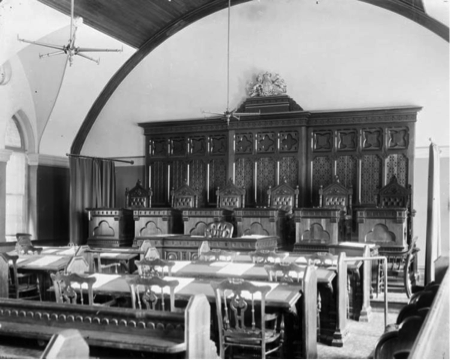The Crucible
When goodly Puritans go badly.
- Course Length: 3 weeks
- Course Type: Short Course
- Category:
- English
- Literature
- High School
Schools and Districts: We offer customized programs that won't break the bank. Get a quote.
When someone says "17th-century Puritan village," you probably think bonnets, buckled shoes, a church on every corner, and a whole lot of praying.
But you could fill a whole book with what that rosy-eyed conception of the goodly Puritans of yore is missing.
In fact, it did fill a whole book. Well, a whole play, to be precise.
Arthur Miller’s The Crucible is a dramatized account of the Salem Witch Trials. There's false accusations, mass hysteria, an execution on every corner, and yes, a whole lot of praying.
But The Crucible doesn't just capture one of the darkest, most morbidly fascinating moments in American history. It's also an allegory for the moral panic and media witch-hunts that still take place today—most specifically, the moral panic and media witch-hunt that was McCarthyism. If you're interested in the power of suggestion, group psychology, and the terrible influence of fear, this is the course for you.
And if the prospect of reading a play about murderous teens, forbidden love, and (feigned) demonic possession doesn't thrill you to the bone, this course also covers
- the difference between dramas and other genres of literature.
- universal themes, like power's corrupting influence, jealousy and revenge, and Shmoop's personal fave, moral ambiguity.
- literary devices, including setting, character, irony, and symbolism.
So what are you waiting for? The witching hour is upon us.
Unit Breakdown
1 The Crucible - The Crucible
In this course, we'll examine witch hunts throughout history, the psychology behind labels, and the unthinkable trials humans subject each other to. Best of all, we'll be reading one of the most riveting plays of all time. (…The Crucible; duh.) Grab your old-timey butter churns and broomsticks, and let's get going.
Sample Lesson - Introduction
Lesson 1.10: I Think, Therefore, I'm Right
The next section includes this doozy of an exchange:
HATHORNE: Martha, will you not admit you are a witch?
MARTHA: I am not a witch. I don't even know what a witch is.
HATHORNE: Well, if you don't know what a witch is, how can you be so sure you aren't one?
MARTHA: What the what?
Okay, so we paraphrased a tad. Our point is, not only are these judges banking the lives of hundreds of people on the word of a half dozen naysayers, refusing to pay any heed to real evidence, and getting moody every time someone tries to point out the error of their ways…they're also not playing fair. Sure, they'll use logic (uh, sort of), but only when it plays into what they've already chosen to believe.
We'd like to point out that the court proceedings are all taking place inside a church. If that's not a perversion of religion, we don't know what is.
Sample Lesson - Reading
Reading 1.1.10: Your Logic is Terrible and Your Breath Smells, Too
The claims that authority figures make in The Crucible are often contradictory, sort of like how Tituba and Abigail couldn't keep their stories straight in the beginning. That's how you know that they're making all of this up as they go along.
Remember in Act I when Hale tells Parris that the Devil may be targeting his house because he likes to go after the most important targets, like ministers? And then, just minutes later, he assures Betty that she's safe with him because the Devil can't overcome a minister?
Truly, Hale, you are of great genius.
But it's not just contradictions that lend humor—a very dark sort of humor—to this play. There's also levels upon levels of irony.
You probably already have a strong grasp of what irony entails, but what the hey. A recap never did anyone any harm.
Except that one time. Shmoop doesn't like to talk about that.
Irony comes in three main forms, most of which entail a contradiction (because we didn't have enough of those already) between literal meaning and actual meaning.
There's verbal irony, which has to do with the tension between what is said and what is really meant. Verbal irony is a lot like sarcasm, the only difference being that sarcasm is meant to be mocking, and verbal irony isn't necessarily.
Then there's situational irony, which plays on the difference between expectations and reality, or intention and result. If your dentist got a cavity, that would be situationally ironic.
Finally, there's dramatic irony, which is when the audience knows something the characters don't. Think Meg Ryan in You've Got Mail. She doesn't know that the man she's been mooning after has been right in front of her all along. But we do.
As you read through the rest of Act III, make a note of any ironies or contradictions that stand out to you.
After you're done, feel free to cross-examine Shmoop's testimony on Act III.
Sample Lesson - Activity
Activity 1.10a: Identifying Irony
Expository Writing Rubric - 15 Points
Sample Lesson - Activity
- Course Length: 3 weeks
- Course Type: Short Course
- Category:
- English
- Literature
- High School
Schools and Districts: We offer customized programs that won't break the bank. Get a quote.
